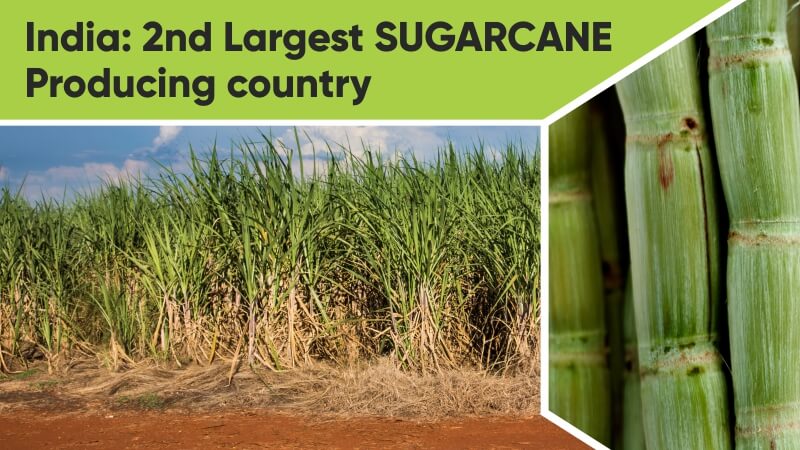From the time of the Vedic civilization, India has grown sugarcane. Sugarcane farming is first mentioned in texts from India between 1400 and 1000 B.C.The two main sources of sugar in the world are sugarcane and sugarbeet. 60% of the sugar produced worldwide comes only from sugarcane. Europe is the next-largest producer of sugar after Asia. While sugarbeet is the primary source of sugar in Europe, sugarcane dominates in Asia.
Currently, sugarcane farming is on 16 million acres of land throughout 79 different nations. There are 112 m.t. of raw sugar produced worldwide. In terms of land (3.93 million hectares) and production (167 million t), India tops the list of nations that grow sugarcane.
Sugarcane farming in India:
The majority of the country’s sugarcane area nearly 50% is in Uttar Pradesh, which is followed by Maharashtra, Karnataka, Tamil Nadu, Andhra Pradesh, Gujarat, Bihar, Haryana, and Punjab. These are the nine states that produce sugarcane. The state of Uttar Pradesh produces the most sugarcane, followed by Maharashtra. Tamilnadu leads the pack in terms of productivity with over 100 tonnes per hectare, followed by Karnataka and Maharashtra. Among the major states that grow sugarcane, Bihar has the lowest productivity levels. The country’s second-largest agro-based industry after textiles is the sugar sector.
Sugarcane thrives more in areas with more or less tropical climates, yet it may also grow in subtropical climates like north India. Around the world, sugarcane is grown between 35° N and 35° S, at elevations ranging from sea level to around 1000 m.
Important Sugarcane Growing Areas and Zones in India:
The two main agro-climatic areas for sugarcane agriculture in India are tropical and subtropical, respectively. Five agroclimatic zones have been determined, nevertheless, primarily for varietal development. They are the North-Western Zone (ii) the North Central Zone (iii) the North Eastern Zone (iv) the Peninsular Zone (v) and (ii) the North Eastern Zone.
A tropical area shared approximately 45 percent and 55 percent of the nation’s total sugarcane production, with an average yield of 77 t/ha. About 55 percent and 45 percent of the total area and sugarcane production, respectively, were in the sub-tropical region, with average productivity of about 63 t/ha.
The states of Maharashtra, Andhra Pradesh, Tamil Nadu, Karnataka, Gujarat, Madhya Pradesh, Goa, Pondicherry, and Kerala are included in agroclimatic zones 4 (peninsular zone) and 5 (coastal zone), which make up the tropical sugarcane region. Sub-tropical region accounts for about 55% of the nation’s total cane area. This region includes Punjab, Haryana, U.P., and Bihar. In India, sugarcane is grown throughout the nation between latitudes 80 N and 330 N, with the exception of chilly mountainous regions like the Kashmir valley, Himachal Pradesh, and Arunachal Pradesh.
Climate Of India: Suitable For Sugarcane farming
A few crucial stages are germination, tillering, early growth, active growth, and elongation. 32° to 38°c is the best temperature range for stem cutting germination (sprouting). It slows down below 25° and hits a plateau between 30° and 34°. The rate of photosynthesis slows and the rate of respiration increases when the temperature exceeds 38 degrees. For ripening, however, temperatures between 12° and 14° are preferable. On sugarcane productivity and juice quality, the weather conditions prevalent during the various crop-growth sub-periods have a considerable impact. The ideal weather for sugar recovery is characterized by dry, low-humidity days with lots of sunshine, cool nights with large diurnal variations, and little rain during the ripening stage. Several reasons induce high sugar accumulation.
Climate-related conditions, such as unusually high or low temperatures, which also have an impact on the sugar’s quality, cause the juice’s quality to deteriorate. Insect pests and illnesses, which flourish in warm, humid conditions, substantially impair the quality, quantity, and sugar content of the juice.
Rainfall: If the distribution is proper, rich in the months of vegetative development followed by a dry period for ripening, a total rainfall between 1100 and 1500 mm is sufficient. Additionally, it grew in regions with little rainfall (up to 500 mm). Rainfall totals over 1500 mm cause the cane to settle.
The top Sugarcane Producing States In India:
India is a heavily agricultural nation, with 60 percent of the population working in the industry. Sugarcane is one of the most significant Kharif crops in the country’s wide variety of crops.
- Uttar Pradesh:
India’s greatest producer of sugarcane in Uttar Pradesh. UP is the largest grower, with more than a million tonnes to be produced. The river Ganga’s dependable water supply is the primary cause of this. The principal districts producing sugarcane in Uttar Pradesh are Meerut, Bareilly, Saharanpur, and Bulandshahr.
- Maharashtra:
Maharashtra comes in at number two among sugarcane growers in India. 12.32 lakh hectares have been planted with sugar cane for the 2021–22 sugar season, and 97 tonnes are anticipated to be produced per hectare. The principal producers are Ahmednagar, Aurangabad, Satara, Solapur, and Pune.
- Tamil Nadu:
Of the top states, Tamil Nadu is the Third-highest producer. The state produces 18.5 MT of sugarcane on average per year. In terms of productivity per hectare, it leads the list. 99 tonnes per hectare are produced on average.
- Karnataka:
The fourth-largest producer of sugarcane in India is Karnataka. Here, the climate is ideal for growing sugarcane of the highest caliber. In 2019–20, it recorded production of over 38 MT. Due to irrigation developments in the Cauvery River, areas like Shimoga, Mysore, Belgaum, and Chitradurga have the highest production rates.
- Andhra Pradesh:
According to India’s top states for producing sugarcane, Andhra Pradesh came in fifth place. Andhra Pradesh’s black alluvial soil is ideal for growing sugarcane. The areas around the Krishna and Godavari rivers profit from them and have access to large-scale sugarcane production.
India ranks among the top nations for sugarcane exports and is one of the greatest producers worldwide. India exported sugar to 60 nations like Iran, Somalia, Malaysia, Sri Lanka, and Afghanistan receiving over 60% of the total shipments. In order to clear the market surplus of sugar in the 2019–20 marketing year, the government permitted the export of 60 lakh tonnes of sugar. During the 2018–19 marketing year, the nation exported 38 lakh tonnes of sugar.
For more information related to sugarcane farming, install the Khetiguru application. For tractor, tractor price, and tractor games-related information visit the KhetiGaadi website.




